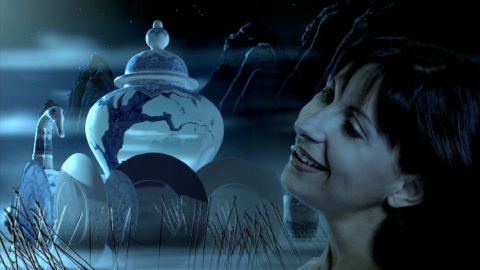|
<< -- 3 -- Robert Anderson SENSUOUS LYRICISM

The palace is put together in a riot of visual effects, both wondrous and distracting. It is very
important to distinguish at once between the nightingale and the cook, who meanders along the palace
terraces apparently miles from any kitchen. Marie McLaughlin sings the part with the assurance that
suggests a large subordinate staff
[watch and listen -- chapter 2, 17:10-18:58].
Her distinctive dress has a convenient brown strip down each lapel. The nightingale, by contrast, might
be a little brown bird winging its way from branch to branch or Natalie Dessay in virginal white. Either
way she sings her exacting part with virtuoso precision; and Albert Schagidullin's emperor, a commanding
figure, is duly impressed
[watch and listen -- chapter 3, 36:00-37:14].

Natalie Dessay as the nightingale. Screenshot © 2005 Agat Films & Cie/ ARTE France / Mikros image
|
It is appropriate, I suppose, that Violeta Urmana as Death should apparently be a chain smoker
as she leans nonchalantly against a palace balustrade. Her aim ought to be the demise of the emperor,
but the nightingale sings her heart out both for our mutual pleasure but also to secure the emperor's
recovery
[watch and listen -- chapter 3, 39:35-40:35].
Her task done, the nightingale has had enough of court life and takes her leave for the fisherman's
company (so Stravinsky thought) but to the evident distress of the emperor, whose cloistered existence
in Chaudet's forbidden city can rarely have been so wondrously and musically beguiled
[watch and listen -- chapter 3, 43:24-44:55].
Continue >>
Copyright © 30 November 2006
Robert Anderson, London UK

|

